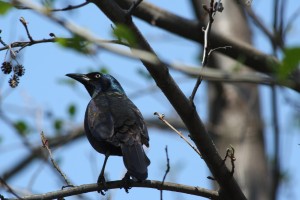Saturday Morning Bird Walks Resume
Posted in Programs and Events, Wildlife on September 3 2009, by Plant Talk
Join Debbie Becker in Looking for Early Migrants
 |
Debbie Becker leads a free bird walk at the Garden every Saturday from 11 a.m. to 12:30 p.m. beginning at the Reflecting Pool in the Leon Levy Visitor Center. |
 While the spring migration is exciting because of the colorful warblers that come through, the fall migration is much more spectacular in other ways. The warblers pass through again, but in drabber colors.
While the spring migration is exciting because of the colorful warblers that come through, the fall migration is much more spectacular in other ways. The warblers pass through again, but in drabber colors.
But it is the hawks, owls, harriers, ospreys, eagles, sparrows, swifts, swallows, and shorebirds on the move that attract most of the attention of bird watchers. The migration begins in late July, when the shorebirds begin showing up on coastal beaches. Osprey follow as they move south to open water. By mid-to-late August we see other species also migrating such as dragonflies and monarch butterflies. By September, the skies will be filled with their movement as well as of swifts and swallows.
As the last days of summer approach in mid-September and heat thermals rise off the Earth, the hawk migration will be in full swing. The hawks use the warm thermals to soar and conserve energy. A good thermal can allow a hawk to coast for miles. Broad-winged hawks are notorious for gliding on thermals in groups of thousands, known as “kettles,” during their migration from North America to South America.
Ruby-throated hummingbirds frequent the Garden during September as the jewelweed comes into bloom, filling their bellies with sweet nectar for the return trip to their wintering grounds. A hummingbird can fly nonstop up to 24 hours and almost 600 miles on stored fat.
As summer yields to autumn bald eagles and golden eagles can be spotted moving westward across New York and New Jersey. Early October brings the sparrows to the area and a chance to spot some of the more uncommon ones such as tree, Lincoln, vesper, or field sparrows.
While the birds are getting ready for the fall migration so are the plants at the Botanical Garden. The fruit of viburnum, cherry, crabapple, Hercules’ club, and other trees and shrubs begin to ripen as the fall approaches, ready to be a source of food for the migrating birds, which help the plants propogate. It is a symbiotic relationship that has been going on for thousands of years. Bull thistle and sunflowers grow tall and strong to supply seeds for the goldfinch, grosbeaks, and sparrows. The birds digest the seeds in their small stomachs and plop-plant the seeds elsewhere during flight. Tanagers, thrush, and thrashers feed on the berries of the dogwood to help fuel their flights back south, thus spreading the berries into the southern states as they fly.
Often I am asked how such small birds can find their way back and forth across the two continents. Science has discovered that birds have small particles of magnetite near their nostrils. It is believed the magnetite helps connect the birds with Earth’s magnetic field and indicates true north. They also use the sun and moon as a compass and landmarks such as NYBG along the way.
The fall migration is wonderful to behold and an event you will not want to miss. The birds and plants put on their most brilliant show at NYBG beginning in September. Come join me September 5 at 11 a.m. when I resume leading the bird walks at the Garden through June.
Sadly, Hawkeye, the adult male red-tailed hawk that nested on the Library building and raised three young this past spring, died July 31. He seems to have ingested poison by eating a rodent that had eaten poison bait, teaching us, once again, that all of nature is connected and reminding us of the impact we have on the food chain. To see photos and read the complete story of eyewitnesses, see the Fordham University blog and The City Birder blog.

